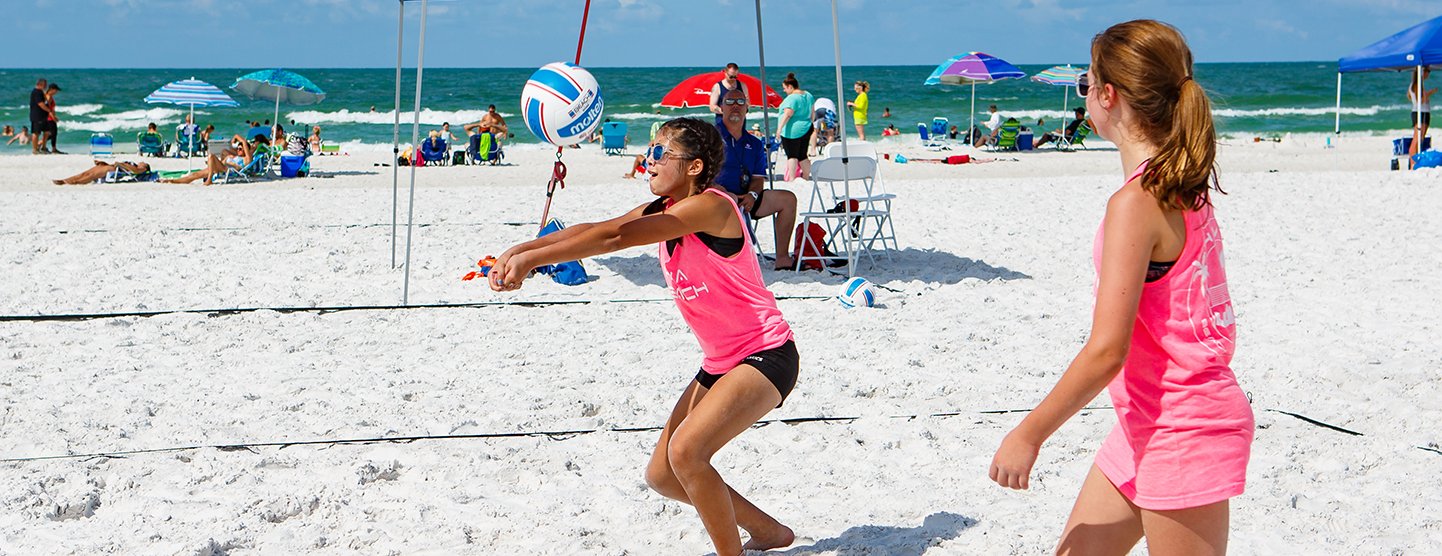
Beach volleyball is one of the fastest growing sports in America. Four NCAA national champions have been crowned on the women’s side, and the sport will make its seventh appearance at the Olympic Games in Tokyo.
There are now opportunities stateside and around the world for juniors and pros to compete on a regular basis at all age levels. You already know the sport’s highlights; how can you join the party and start a beach program?
Run A Training Program Only; Everything Else is Optional
“Simple is better than complex.”
We use this principle on the court, and it applies to our program as well. In beach volleyball you do not need uniforms or a coach. All you need to start your first match are four players, a ball and a court. Our program charges each player to train over the summer, and that is it.
Everything else the players want to do falls under optional “add-ons” which we help them through each step of the way. Many players add on local and national competitions, uniforms and extra practices or lessons.
Budget for a “One-Court Program, and Keep Going From There
Typically, one court serves 8-12 players, one head coach and an assistant (or just a parent as you get started). It’s best to have two adults present for safety and supervision. All adults should be USAV members, background checked, and have completed SafeSport. You should also anticipate needing the following equipment:
- Doubles lines ($30-$60). We recommend two-inch lines with sand plates.
- Volleyballs (cost varies by brand). The ball you get depends on the competition you will choose. As a new program you can either purchase 4-12 balls per court or ask the athletes to buy and bring a ball to every practice.
- Volleyball net (~$100). If you train at a park with just poles all you need is to bring a net.
- Pool noodles or antenna to mark the sideline and split into “skinny” courts.
To create a bare bones program that is all you will need. Some additional frills might include a pop-up shade, a camping chair and a cooler to offer players a break from the heat and sun. It is important to note that athletes can sign up for tournaments on their own, and they range from $50 per team for a single-day event, to as much as $250 for a multi-day national event.
Find a Practice Schedule and Location That Fits Your Needs
A good place to start is your local park districts. They likely have multiple courts open to the public that you could use for free or pay to reserve. When looking for courts, be on the lookout for a shelter for safety, as well as restrooms. You want to check the net systems to ensure they are properly installed and are in good working order. Finally, it’s important to check the sand quality and depth to avoid injury and keep your players coming back.
We recommend an eight-week program, 90 minutes each session, two times per week. Our favorite training session is from 9-10:30 a.m., before it gets too hot. We do, however, train at all times of the day with 1-3 p.m., being our least favorite. We have a strong preference for morning sessions rather than evening.
Take Time to Understand the Local and National Beach Scene
Each year the landscape changes. The value you have as a beach club resides deeply in your understanding of a rapidly changing culture. Reach out to your region’s beach volleyball representative, join different Facebook groups like “Beach Volleyball Coaches,” and call an NCAA school that has beach volleyball to ask questions. Learn more about the Beach National Team Development Program and Beach National Team programs.
There are many different events and organizations at the junior level, so take the time to properly educate yourself about your community and what opportunities exist around the country.
Embrace the Culture of the Sport
The temptation in starting a beach “club” is to model it after the successful indoor programs. Resist that temptation. While a forearm pass is still a forearm pass, there are more differences than similarities. As my friend (USA Volleyball Director of Sport Development) John Kessel says, “We are here to help create a space for the athletes to learn the game by playing the game.”
Coaches have far less control during matches. At most tournaments, we are permitted to walk and talk with the players at the side switch, at timeouts and after the game, and that’s all. Embrace that culture in practice, and encourage their success in becoming self-sufficient. Pick your moments to walk and talk.
Now go out and have fun! I hope starting a beach club is the most rewarding and exciting experience you have this summer and for many years to come.
If you have any questions, contact Tim at tmaruyama@chicagosandvolleyball.org to get help starting your program.
